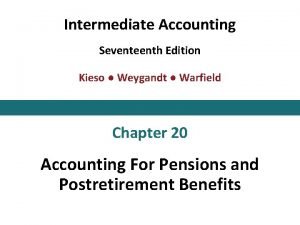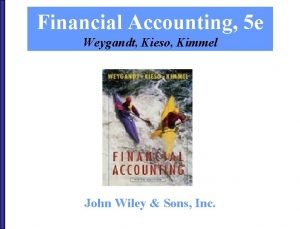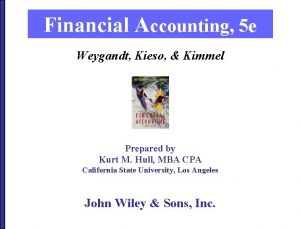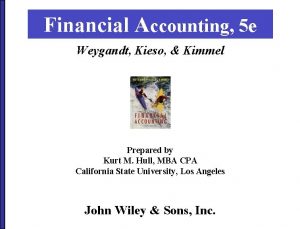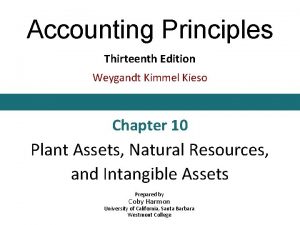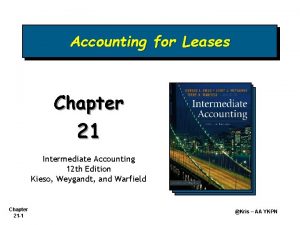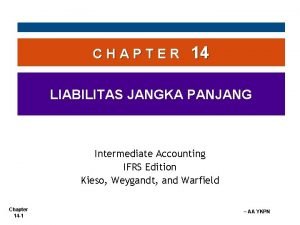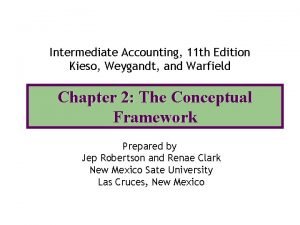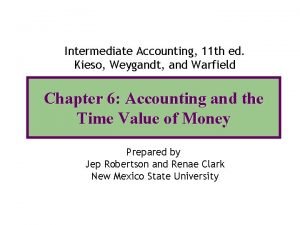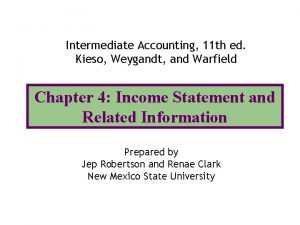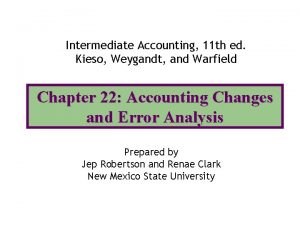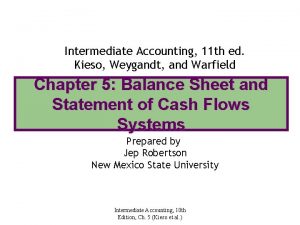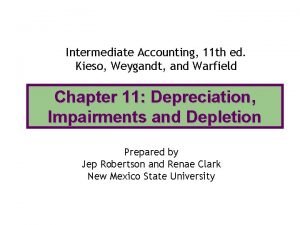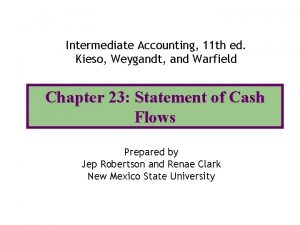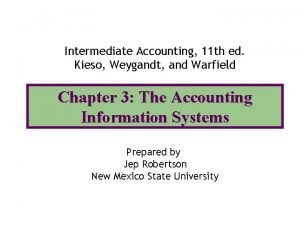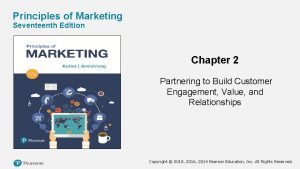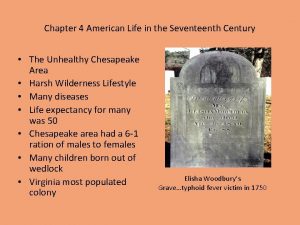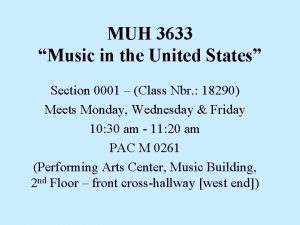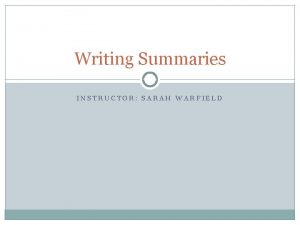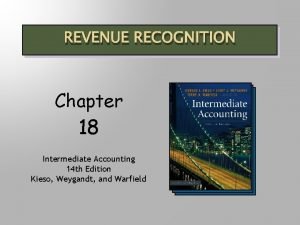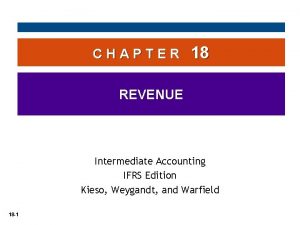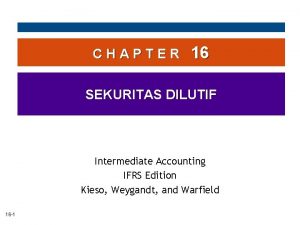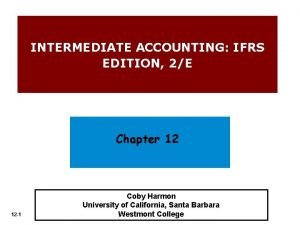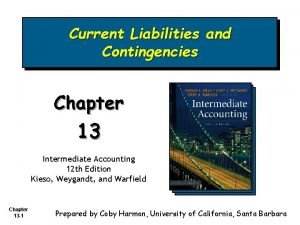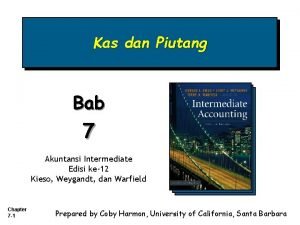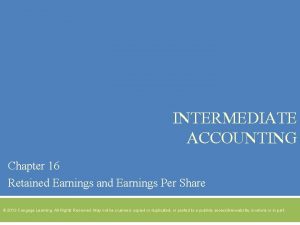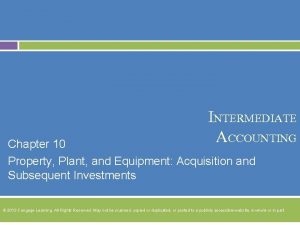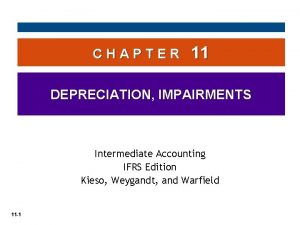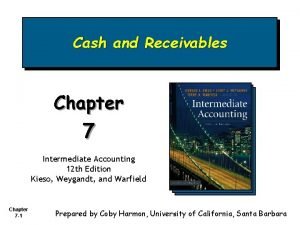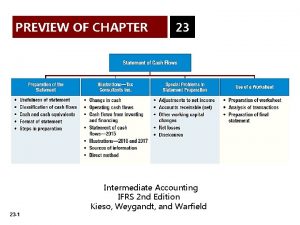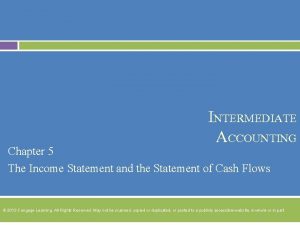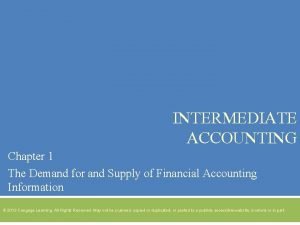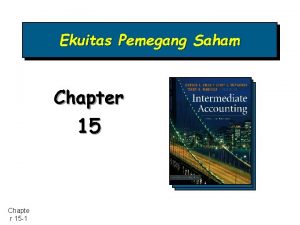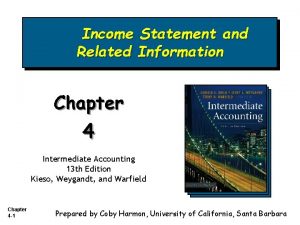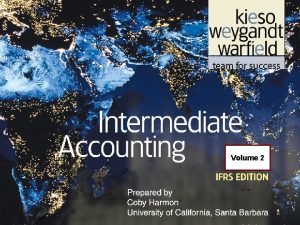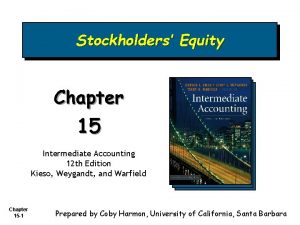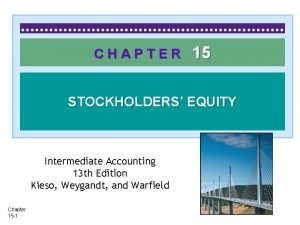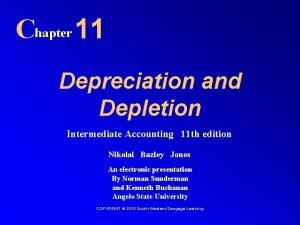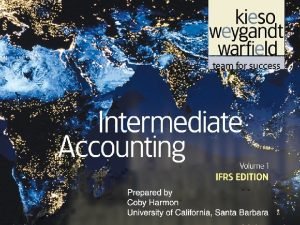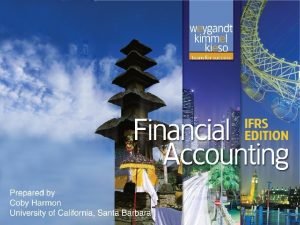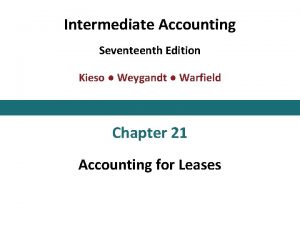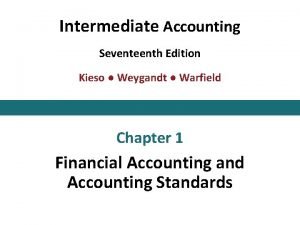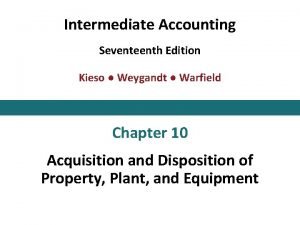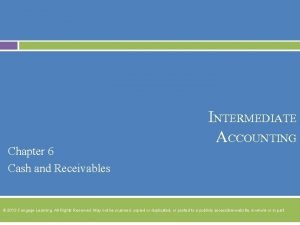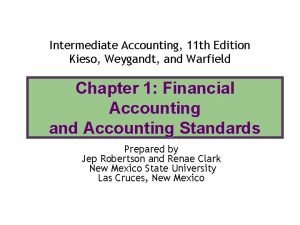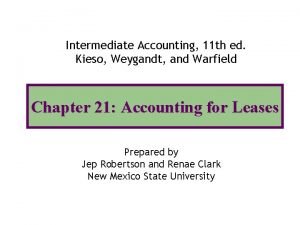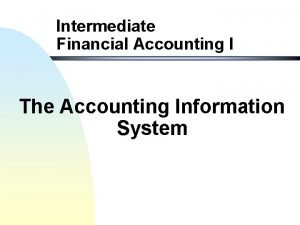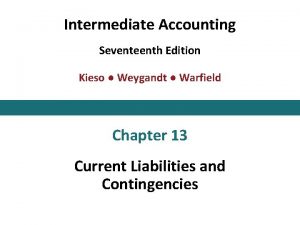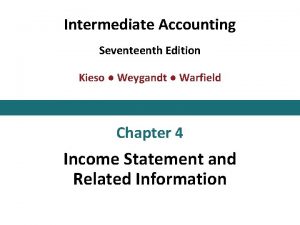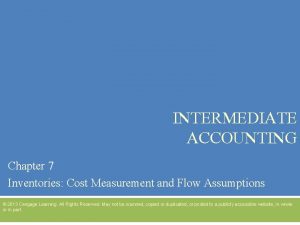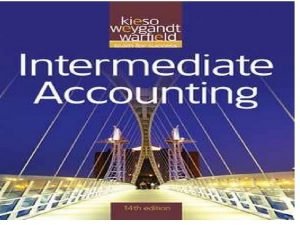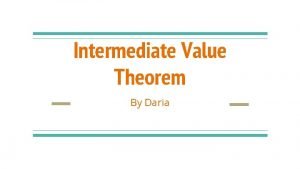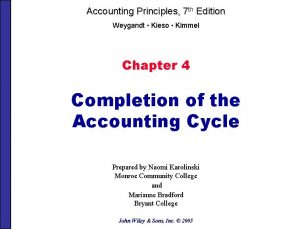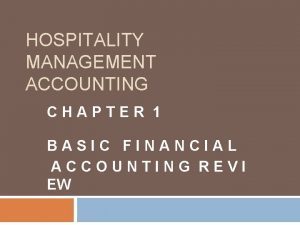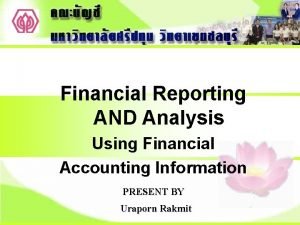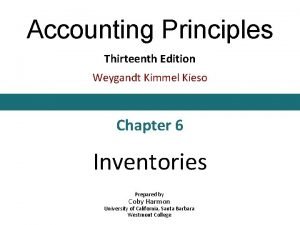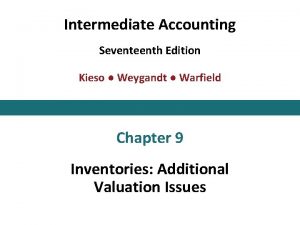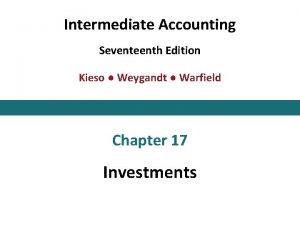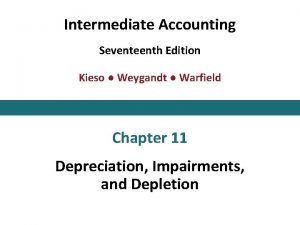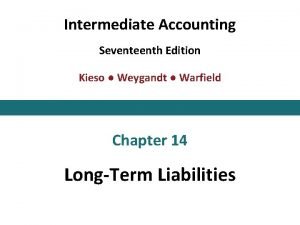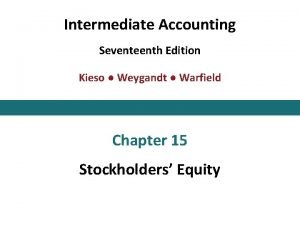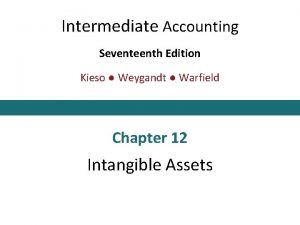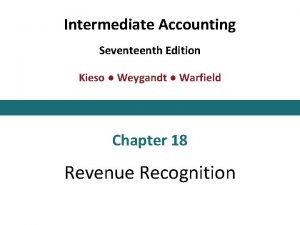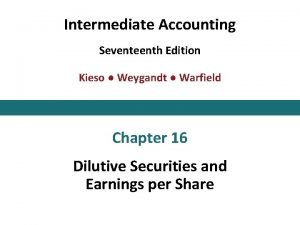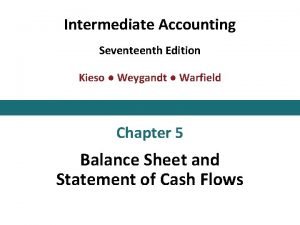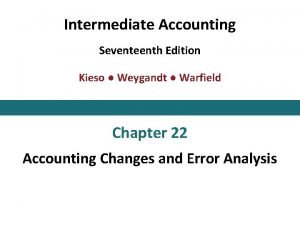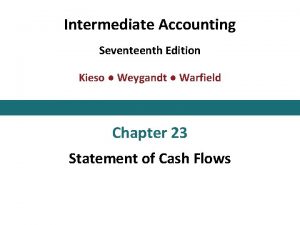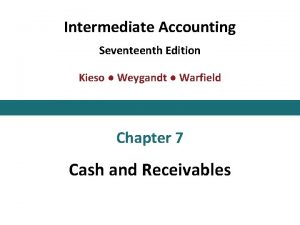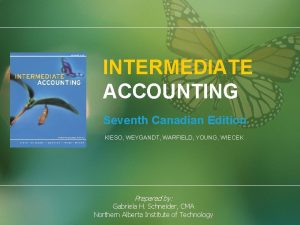Intermediate Accounting Seventeenth Edition Kieso Weygandt Warfield Chapter



















































































- Slides: 83

Intermediate Accounting Seventeenth Edition Kieso ● Weygandt ● Warfield Chapter 10 Acquisition and Disposition of Property, Plant, and Equipment This slide deck contains animations. Please disable animations if they cause issues with your device.

Learning Objectives After studying this chapter, you should be able to: 1. Identify property, plant, and equipment and its related costs. 2. Discuss the accounting problems associated with interest capitalization. 3. Explain the accounting issues related to acquiring and valuing plant assets. 4. Describe the accounting treatment for costs subsequent to acquisition. 5. Describe the accounting treatment for the disposal of property, plant, and equipment. Copyright © 2019 John Wiley & Sons, Inc. 2

Preview of Chapter 10 Acquisition and Disposition of Property, Plant, and Equipment Property, Plant, and Equipment • Acquisition of property, plant, and equipment • Cost of land • Cost of buildings • Cost of equipment • Self-constructed assets Copyright © 2019 John Wiley & Sons, Inc. 3

Preview of Chapter 10 Interest Costs During Construction • Qualifying assets • Capitalization period • Amount to capitalize • Example • Special issues • Observations Copyright © 2019 John Wiley & Sons, Inc. 4

Preview of Chapter 10 Valuation of Property, Plant, and Equipment • Cash discounts • Deferred-payment contracts • Lump-sum purchases • Issuance of stock • Exchanges of nonmonetary assets • Other valuation methods Copyright © 2019 John Wiley & Sons, Inc. 5

Preview of Chapter 10 Costs Subsequent to Acquisition • Additions • Improvements and replacements • Rearrangement and reinstallation • Repairs • Summary Copyright © 2019 John Wiley & Sons, Inc. 6

Preview of Chapter 10 Disposition of Property, Plant, and Equipment • Sale of plant assets • Involuntary conversion • Miscellaneous problems Copyright © 2019 John Wiley & Sons, Inc. 7

Learning Objective 1 Understand Property, Plant, and Equipment and Its Related Costs LO 1 Copyright © 2019 John Wiley & Sons, Inc. 8

Property, Plant, and Equipment Property, plant, and equipment are assets of a durable nature. Other terms commonly used are plant assets and fixed assets. • Used in operations and not for resale • Long-term in nature and usually depreciated • Possess physical substance Includes land, building structures (offices, factories, warehouses), and equipment (machinery, furniture, tools). LO 1 Copyright © 2019 John Wiley & Sons, Inc. 9

Property, Plant, and Equipment Acquisition of Property, Plant, and Equipment Historical cost measures the cash or cash equivalent price of obtaining the asset and bringing it to the location and condition necessary for its intended use. Main reasons for historical cost valuation: • Historical cost is reliable • Companies should not anticipate gains and losses but should recognize gains and losses only when asset is sold LO 1 Copyright © 2019 John Wiley & Sons, Inc. 10

Property, Plant, and Equipment Cost of Land Includes all expenditures to acquire land ready it for use. Costs typically include: 1) purchase price; 2) closing costs, such as title to the land, attorney’s fees, and recording fees; 3) costs of grading, filling, draining, and clearing; 4) assumption of any liens, mortgages, or encumbrances on the property; and 5) additional land improvements having an indefinite life. LO 1 Copyright © 2019 John Wiley & Sons, Inc. 11

Cost of Land Improvements with limited lives, such as private driveways, walks, fences, and parking lots, are recorded as Land Improvements and depreciated. • Land acquired and held for speculation is classified as an investment • Land held by a real estate concern for resale should be classified as inventory LO 1 Copyright © 2019 John Wiley & Sons, Inc. 12

Property, Plant, and Equipment Cost of Buildings Includes all expenditures related directly to acquisition or construction. Costs include: • materials, labor, and overhead costs incurred during construction and • professional fees and building permits LO 1 Copyright © 2019 John Wiley & Sons, Inc. 13

Property, Plant, and Equipment Cost of Equipment Include all expenditures incurred in acquiring the equipment and preparing it for use. Costs include: • purchase price • freight and handling charges • insurance on the equipment while in transit • cost of special foundations if required • assembling and installation costs • costs of conducting trial runs LO 1 Copyright © 2019 John Wiley & Sons, Inc. 14

Property, Plant, and Equipment Self-Constructed Assets Costs include: 1. Materials and direct labor 2. Overhead can be handled in two ways: • Assign no fixed overhead • Assign a portion of all overhead to the construction process Companies use the second method extensively. LO 1 Copyright © 2019 John Wiley & Sons, Inc. 15

Property, Plant, and Equipment Illustration: The expenditures and receipts below are related to land, land improvements, and buildings acquired for use. Determine how the following should be classified: a. Money borrowed to pay building contractor Notes Payable b. Payment for construction from note proceeds c. Cost of land fill and clearing d. Delinquent real estate taxes on property assumed Building Land e. Premium on 6 -month insurance policy during construction Building f. Refund of 1 -month insurance premium because construction completed early (Building) LO 1 Copyright © 2019 John Wiley & Sons, Inc. 16

Property, Plant, and Equipment Page 2 Illustration: The expenditures and receipts below are related to land, land improvements, and buildings acquired for use. Determine how the following should be classified: Building g. Cost of parking lots and driveways h. Commission fee paid to real estate agency i. Installation of fences around property j. Cost of razing and removing building Land Improvements Land k. Cost of real estate purchased as a plant site (land $200, 000 and building $50, 000) Building l. Proceeds from salvage of demolished building (Land) LO 1 Copyright © 2019 John Wiley & Sons, Inc. 17

Property, Plant, and Equipment Page 3 Illustration: The expenditures and receipts below are related to land, land improvements, and buildings acquired for use. Determine how the following should be classified: m. Architect’s fee on building n. Cost of trees and shrubbery (permanent) LO 1 Copyright © 2019 John Wiley & Sons, Inc. Land Improvements Land 18

Learning Objective 2 Discuss the Accounting Problems Associated with Interest Capitalization LO 2 Copyright © 2019 John Wiley & Sons, Inc. 19

Interest Costs During Construction Three approaches have been suggested to account for the interest incurred in financing the construction. LO 2 Copyright © 2019 John Wiley & Sons, Inc. 20

Interest Costs During Construction Capitalization of Interest Costs • GAAP requires — capitalizing actual interest (with modification) • Consistent with historical cost • Capitalization considers three items: 1. Qualifying assets. 2. Capitalization period. 3. Amount to capitalize. LO 2 Copyright © 2019 John Wiley & Sons, Inc. 21

Interest Costs During Construction Qualifying Assets Require a period of time to get them ready for their intended use. Two types of assets: • Assets under construction for a company’s own use • Assets intended for sale or lease that are constructed or produced as discrete projects LO 2 Copyright © 2019 John Wiley & Sons, Inc. 22

Interest Costs During Construction Capitalization Period Begins when: 1. Expenditures for the asset have been made. 2. Activities for readying the asset are in progress. 3. Interest costs are being incurred. Ends when: The asset is substantially complete and ready for use. LO 2 Copyright © 2019 John Wiley & Sons, Inc. 23

Interest Costs During Construction Amount to Capitalize the lesser of: 1. Actual interest costs. 2. Avoidable interest - the amount of interest cost during the period that a company could theoretically avoid if it had not made expenditures for the asset. LO 2 Copyright © 2019 John Wiley & Sons, Inc. 24

Interest Costs During Construction Interest Capitalization Illustration: Assume a company borrowed $200, 000 at 12% interest from State Bank on Jan. 1, 2020, for specific purposes of constructing special-purpose equipment to be used in its operations. Construction on the equipment began on Jan. 1, 2020, and the following expenditures were made prior to the project’s completion on Dec. 31, 2020: Actual Expenditures during 2020: January 1 April 30 November 1 December 31 Total expenditures LO 2 $100, 000 150, 000 300, 000 100, 000 $650, 000 Other general debt existing on Jan. 1, 2020: $500, 000, 14%, 10 -year bonds payable $300, 000, 10%, 5 -year note payable Copyright © 2019 John Wiley & Sons, Inc. 25

Interest Costs During Construction Step 1 - Determine which assets qualify for capitalization of interest. Special purpose equipment qualifies because it requires a period of time to get ready and it will be used in the company’s operations. Step 2 - Determine the capitalization period. The capitalization period is from Jan. 1, 2020 through Dec. 31, 2020, because expenditures are being made and interest costs are being incurred during this period while construction is taking place. LO 2 Copyright © 2019 John Wiley & Sons, Inc. 26

Interest Costs During Construction Step 3 - Compute weighted-average accumulated expenditures. Actual Date Expenditures Jan. 1 $100, 000 Apr. 30 150, 000 Nov. 1 300, 000 Dec. 31 100, 000 $650, 000 Capitalization Period x 12/12 8/12 2/12 0/12 Weighted Average Accumulated Expenditures = $100, 000 50, 000 - $250, 000 A company weights the construction expenditures by the amount of time (fraction of a year or accounting period) that it can incur interest cost on the expenditure. LO 2 Copyright © 2019 John Wiley & Sons, Inc. 27

Interest Costs During Construction Step 4 - Compute the Actual and Avoidable Interest. Selecting Appropriate Interest Rate: 1. For the portion of weighted-average accumulated expenditures that is less than or equal to any amounts borrowed specifically to finance construction of the assets, use the interest rate incurred on the specific borrowings. 2. For the portion of weighted-average accumulated expenditures that is greater than any debt incurred specifically to finance construction of the assets, use a weighted average of interest rates incurred on all other outstanding debt during the period. LO 2 Copyright © 2019 John Wiley & Sons, Inc. 28

Compute Actual and Avoidable Interest LO 2 Copyright © 2019 John Wiley & Sons, Inc. 29

Interest Costs During Construction Step 5 – Capitalize the lesser of Avoidable interest or Actual interest. Avoidable interest Actual interest $ 30, 250 124, 000 Journal entry to Capitalize Interest: Equipment Interest Expense LO 2 30, 250 Copyright © 2019 John Wiley & Sons, Inc. 30, 250 30

Interest Costs During Construction Comprehensive Illustration On November 1, 2019, Shalla Company contracted Pfeifer Construction Co. to construct a building for $1, 400, 000 on land costing $100, 000 (purchased from the contractor and included in the first payment). Shalla made the following payments to the construction company during 2020. January 1 March 1 May 1 December 31 Total $210, 000 $300, 000 $540, 000 $450, 000 $1, 500, 000 LO 2 Copyright © 2019 John Wiley & Sons, Inc. 31

Comprehensive Illustration Pfeifer Construction completed the building, ready for occupancy, on December 31, 2020. Shalla had the following debt outstanding at December 31, 2020. Specific Construction Debt 1. 15%, 3 -year note to finance purchase of land construction of the building, dated December 31, 2019, with interest payable annually on December 31 $750, 000 Other Debt 2. 10%, 5 -year note payable, dated December 31, 2016, with interest payable annually on December 31 $550, 000 3. 12%, 10 -year bonds issued December 31, 2015, with interest payable annually on December 31 $600, 000 LO 2 Copyright © 2019 John Wiley & Sons, Inc. 32

Interest Costs During Construction Computation of Weighted-Average Accumulated Expenditures LO 2 Copyright © 2019 John Wiley & Sons, Inc. 33

Interest Costs During Construction Computation of Avoidable Interest LO 2 Copyright © 2019 John Wiley & Sons, Inc. 34

Interest Costs During Construction Computation of Actual Interest Compute the actual interest cost, which represents the maximum amount of interest that it may capitalize during 2020. The interest cost that Shalla capitalizes is the lesser of $120, 228 (avoidable interest) and $239, 500 (actual interest), or $120, 228. LO 2 Copyright © 2019 John Wiley & Sons, Inc. 35

Journal Entries for 2020 January 1 Land Buildings (or CIP) Cash Buildings March 1 Cash Buildings May 1 Cash December 31 Buildings Cash Buildings (Capitalized Interest) Interest Expense Cash LO 2 Copyright © 2019 John Wiley & Sons, Inc. 100, 000 110, 000 210, 000 300, 000 540, 000 450, 000 120, 228 119, 272 239, 500 36

Interest Costs During Construction Capitalized Interest Reported in the Income Statement At December 31, 2020, Shalla discloses the amount of interest capitalized either as part of the income statement or in the notes accompanying the financial statements. LO 2 Copyright © 2019 John Wiley & Sons, Inc. 37

Interest Capitalization - Special Issues 1. Expenditures for Land • If the company purchases land as a site for a structure, interest costs capitalized are part of the cost of the plant, not the land • Conversely, if the company develops land for lot sales, it includes any capitalized interest cost as part of the acquisition cost of the developed land 2. Interest Revenue • Companies should not net or offset interest revenue against interest cost LO 2 Copyright © 2019 John Wiley & Sons, Inc. 38

Learning Objective 3 Explain the Accounting Issues Related to Acquiring and Valuing Plant Assets LO 3 Copyright © 2019 John Wiley & Sons, Inc. 39

Valuation of Property, Plant, and Equipment Companies should record property, plant, and equipment: • at the fair value of what they give up or • at the fair value of the asset received, whichever is more clearly evident. LO 3 Copyright © 2019 John Wiley & Sons, Inc. 40

Valuation of PP&E Cash Discounts — Discount for prompt payment. Deferred-Payment Contracts — Assets purchased on long-term credit contracts at the present value of the consideration exchanged. Lump-Sum Purchases — Allocate the total cost among the various assets on the basis of their relative fair market values. Issuance of Stock — The market price of the stock issued is a fair indication of the cost of the property acquired. LO 3 Copyright © 2019 John Wiley & Sons, Inc. 41

Valuation of PP&E Exchanges of Nonmonetary Assets Ordinarily accounted for on the basis of: • the fair value of the asset given up or • the fair value of the asset received, whichever is clearly more evident. Companies should recognize immediately any gains or losses on the exchange when the transaction has commercial substance. LO 3 Copyright © 2019 John Wiley & Sons, Inc. 42

Exchanges of Nonmonetary Assets Meaning of Commercial Substance Exchange has commercial substance if the future cash flows change as a result of the transaction. That is, if the two parties’ economic positions change, the transaction has commercial substance. Type of Exchange Accounting Guidance Exchange has commercial substance. Recognize gains and losses immediately. Exchange lacks commercial substance —no cash received. Defer gains; recognize losses immediately. Exchange lacks commercial substance —cash received. Recognize partial gain; recognize losses immediately. * * If cash is 25% or more of the fair value of the exchange, recognize entire gain because earnings process is complete. LO 3 Copyright © 2019 John Wiley & Sons, Inc. 43

Exchanges of Nonmonetary Assets Exchanges—Loss Situation Companies recognize a loss immediately whether the exchange has commercial substance or not. Rationale: Companies should not value assets at more than their cash equivalent price; if the loss were deferred, assets would be overstated. LO 3 Copyright © 2019 John Wiley & Sons, Inc. 44

Exchanges—Loss Situation Illustration: Information Processing, Inc. trades its used machine for a new model at Jerrod Business Solutions Inc. The exchange has commercial substance. The used machine has a book value of $8, 000 (original cost $12, 000 less $4, 000 accumulated depreciation) and a fair value of $6, 000. The new model lists for $16, 000. Jerrod gives Information Processing a trade-in allowance of $9, 000 for the used machine. Information Processing computes the cost of the new asset as follows. List price of new machine Less: Trade-in allowance for used machine 9, 000 Cash payment due 7, 000 Fair value of used machine 6, 000 Cost of new machine LO 3 $16, 000 $13, 000 Copyright © 2019 John Wiley & Sons, Inc. 45

Exchanges—Loss Situation Illustration Information Processing records this transaction as follows: Equipment Accumulated Depreciation—Equipment Loss on Disposal of Equipment 13, 000 4, 000 2, 000 12, 000 Equipment Cash Loss on Disposal LO 3 7, 000 Fair value of used machine $6, 000 Less: Book value of used machine 8, 000 Loss on disposal of used machine $2, 000 Copyright © 2019 John Wiley & Sons, Inc. 46

Exchanges of Nonmonetary Assets Exchanges—Gain Situation Has Commercial Substance. Company usually records the cost of a nonmonetary asset acquired in exchange for another nonmonetary asset at the fair value of the asset given up, and immediately recognizes a gain. LO 3 Copyright © 2019 John Wiley & Sons, Inc. 47

Exchanges—Gain Situation Illustration: Interstate Transportation Company exchanged a number of used trucks plus cash for a semi-truck. The used trucks have a combined book value of $42, 000 (cost $64, 000 less $22, 000 accumulated depreciation). Interstate’s purchasing agent, experienced in the secondhand market, indicates that the used trucks have a fair market value of $49, 000. In addition to the trucks, Interstate must pay $11, 000 cash for the semi-truck. Interstate computes the cost of the semi-truck as follows. Fair value of trucks exchanged Cash paid Cost of semi-truck LO 3 $49, 000 11, 000 $60, 000 Copyright © 2019 John Wiley & Sons, Inc. 48

Exchanges—Gain Situation Illustration Interstate records the exchange transaction as follows: Truck (semi) Accumulated Depreciation—Trucks (used) Gain on Disposal of Trucks Cash 60, 000 22, 000 Gain on Disposal Fair value of used trucks Cost of used trucks, net of accumulated depreciation Gain on disposal of used trucks LO 3 Copyright © 2019 John Wiley & Sons, Inc. 64, 000 7, 000 11, 000 $ 49, 000 (42, 000) $ 7, 000 49

Exchanges—Gain Situation Lacks Commercial Substance—No Cash Received Now assume that Interstate Transportation Company exchange lacks commercial substance. Interstate defers the gain of $7, 000 and reduces the basis of the semi-truck. LO 3 Copyright © 2019 John Wiley & Sons, Inc. 50

Lacks Commercial Substance—No Cash Received Illustration: Interstate records the exchange transaction as follows: Truck (semi) Accumulated Depreciation—Trucks (used) Cash LO 3 Copyright © 2019 John Wiley & Sons, Inc. 53, 000 22, 000 64, 000 11, 000 51

Exchanges—Gain Situation Lacks Commercial Substance—Some Cash Received When a company receives cash (sometimes referred to as “boot”) in an exchange that lacks commercial substance, it may immediately recognize a portion of the gain. The general formula for gain recognition when an exchange includes some cash is as follows: LO 3 Copyright © 2019 John Wiley & Sons, Inc. 52

Lacks Commercial Substance—Some Cash Received Illustration: Queenan Corporation traded in used machinery with a book value of $60, 000 (cost $110, 000 less accumulated depreciation $50, 000) and a fair value of $100, 000. It receives in exchange a machine with a fair value of $90, 000 plus cash of $10, 000. Fair value of machine exchanged Less: Book value of machine exchanged Total gain LO 3 Copyright © 2019 John Wiley & Sons, Inc. $100, 000 60, 000 $ 40, 000 53

Lacks Commercial Substance—Some Cash Received Computation of Gain The portion of the gain a company recognizes is the ratio of monetary assets (cash in this case) to the total consideration received. LO 3 Copyright © 2019 John Wiley & Sons, Inc. 54

Lacks Commercial Substance—Some Cash Received Computation of Basis LO 3 Copyright © 2019 John Wiley & Sons, Inc. 55

Lacks Commercial Substance—Some Cash Received Journal Entry Queenan would record the following entry. Cash 10, 000 Machine (new) 54, 000 Accumulated Depreciation—Machinery Machine Gain on Disposal of Machinery LO 3 Copyright © 2019 John Wiley & Sons, Inc. 50, 000 110, 000 4, 000 56

Summary of Gain and Loss Recognition 1. Compute the total gain or loss on the transaction. This amount is equal to the difference between the fair value of the asset given up and the book value of the asset given up. 2. If a loss is computed in Step 1, always recognize the entire loss. 3. If a gain is computed in Step 1, (a) and the exchange has commercial substance, recognize the entire gain. (b) and the exchange lacks commercial substance, 1) and no cash is involved, no gain is recognized. 2) and some cash is given, no gain is recognized. 3) and some cash is received, the following portion of the gain is recognized: *lf the amount of cash exchanged is 25% or more, both parties recognize entire gain or loss. LO 3 Copyright © 2019 John Wiley & Sons, Inc. 57

Exchanges of Nonmonetary Assets Illustration Santana Company exchanged equipment used in its manufacturing operations plus $2, 000 in cash for similar equipment used in the operations of Delaware Company. The following information pertains to the exchange. Santana Delaware Equipment (cost) $28, 000 Accumulated depreciation 19, 000 10, 000 Fair value of equipment 13, 500 15, 500 Cash given up 2, 000 Instructions: Prepare the journal entries to record the exchange on the books of both companies LO 3 Copyright © 2019 John Wiley & Sons, Inc. 58

Exchanges of Nonmonetary Assets Calculation of Gain or Loss Fair value of equipment received Cash received / paid Less: Book value of equipment ($28, 000− 19, 000) ($28, 000− 10, 000) Gain or (Loss) on Exchange LO 3 Santana $15, 500 (2, 000) (9, 000) $ 4, 500 Copyright © 2019 John Wiley & Sons, Inc. Delaware $13, 500 2, 000 (18, 000) $ (2, 500) 59

Has Commercial Substance Journal Entries Santana: Equipment 15, 500 Accumulated Depreciation Cash 2, 000 Equipment Gain on Exchange 19, 000 28, 000 4, 500 Delaware: Cash Equipment Accumulated Depreciation Loss on Exchange Equipment LO 3 2, 000 13, 500 10, 000 2, 500 Copyright © 2019 John Wiley & Sons, Inc. 28, 000 60

Santana (Has Commercial Substance): Equipment 15, 500 Accumulated Depreciation 19, 000 Cash 2, 000 Equipment 28, 000 Gain on Disposal of Equipment 4, 500 Santana (LACKS Commercial Substance): Equipment (15, 500 – 4, 500) Accumulated Depreciation Cash 2, 000 Equipment LO 3 11, 000 19, 000 28, 000 Copyright © 2019 John Wiley & Sons, Inc. 61

Delaware (Has Commercial Substance): Cash 2, 000 Equipment 13, 500 Accumulated Depreciation 10, 000 Loss on Disposal of Equipment 2, 500 Equipment 28, 000 Delaware (LACKS Commercial Substance): Cash 2, 000 Equipment 13, 500 Accumulated Depreciation 10, 000 Loss on Disposal of Equipment 2, 500 Equipment 28, 000 LO 3 Copyright © 2019 John Wiley & Sons, Inc. 62

Learning Objective 4 Describe the Accounting Treatment for Costs Subsequent to Acquisition LO 4 Copyright © 2019 John Wiley & Sons, Inc. 63

Costs Subsequent to Acquisition In general, costs incurred to achieve greater future benefits should be capitalized, whereas expenditures that simply maintain a given level of services should be expensed. In order to capitalize costs, one of three conditions must be present: 1. useful life must be increased, 2. quantity of units produced must be increased, and 3. quality of units produced must be enhanced. LO 4 Copyright © 2019 John Wiley & Sons, Inc. 64

Costs Subsequent to Acquisition Major Types of Expenditures Additions. Increase or extension of existing assets. Improvements and Replacements. Substitution of an improved asset for an existing one. Rearrangement and Reinstallation. Movement of assets from one location to another. Repairs. Expenditures that maintain assets in condition for operation. LO 4 Copyright © 2019 John Wiley & Sons, Inc. 65

Summary of Costs Subsequent to Acquisition Type of Expenditure Normal Accounting Treatment Additions Improvements and replacements Capitalize cost of addition to asset account. (a) Carrying value known: Remove cost of and accumulated depreciation on old asset, recognizing any gain or loss. Capitalize cost of improvement/ replacement. (b) Carrying value unknown: 1. If the asset's useful life is extended, debit accumulated depreciation for cost of improvement/replacement. 2. If the quantity or quality of the asset's productivity is increased, capitalize cost of improvement/replacement to asset account. LO 4 Copyright © 2019 John Wiley & Sons, Inc. 66

Summary of Costs Rearrangement and Reinstallation Type of Expenditure Normal Accounting Treatment Rearrangement and reinstallation (a) If original installation cost is known, account for cost of rearrangement/reinstallation as a replacement (carrying value known). (b) If original installation cost is unknown and rearrangement/reinstallation cost is material in amount and benefits future periods, capitalize as an asset. (c) If original installation cost is unknown and rearrangement/reinstallation cost is not material or future benefit is questionable, expense the cost when incurred. LO 4 Copyright © 2019 John Wiley & Sons, Inc. 67

Summary of Costs Repairs Type of Expenditure Repairs LO 4 Normal Accounting Treatment (a) Ordinary: Expense cost of repairs when incurred. (b) Major: As appropriate, treat as an addition, improvement, or replacement. Copyright © 2019 John Wiley & Sons, Inc. 68

Learning Objective 5 Describe the Accounting Treatment for the Disposal of Property, Plant, and Equipment LO 5 Copyright © 2019 John Wiley & Sons, Inc. 69

Disposition of Property, Plant, and Equipment (PP&E) A company may retire plant assets voluntarily or dispose of them by • Sale, • Exchange, • Involuntary conversion, or • Abandonment. Depreciation must be taken up to the date of disposition. Copyright © 2019 John Wiley & Sons, Inc. 70

Disposition of PP&E Sale of Plant Assets Illustration: Barret Company recorded depreciation on a machine costing $18, 000 for 9 years at the rate of $1, 200 per year. If it sells the machine in the middle of the tenth year for $7, 000, Barret records depreciation to the date of sale as: Equipment ($1, 200 x ½) Accumulated Depreciation Copyright © 2019 John Wiley & Sons, Inc. 600 71

Sale of Plant Assets Journal Entry Illustration: Barret Company recorded depreciation on a machine costing $18, 000 for 9 years at the rate of $1, 200 per year. If it sells the machine in the middle of the tenth year for $7, 000, Barret records depreciation to the date of sale. Record the entry to record the sale of the asset: Cash Accumulated Depreciation Machinery Gain on Disposal of Machinery Copyright © 2019 John Wiley & Sons, Inc. 7, 000 11, 400 18, 000 400 72

Disposition of PP&E Involuntary Conversion Sometimes an asset’s service is terminated through some type of involuntary conversion such as fire, flood, theft, or condemnation. Companies report the difference between the amount recovered (e. g. , from a condemnation award or insurance recovery), if any, and the asset’s book value as a gain or loss. They treat these gains or losses like any other type of disposition. Copyright © 2019 John Wiley & Sons, Inc. 73

Involuntary Conversion Illustration: Camel Transport Corp. had to sell a plant located on company property that stood directly in the path of an interstate highway. For a number of years, the state had sought to purchase the land on which the plant stood, but the company resisted. The state ultimately exercised its right of eminent domain, which the courts upheld. In settlement, Camel received $500, 000, which substantially exceeded the $200, 000 book value of the plant and land (cost of $400, 000 less accumulated depreciation of $200, 000). Camel made the following entry. Cash 500, 000 Accumulated Depreciation—Plant Assets 200, 000 Plant Assets 400, 000 Gain on Disposal of Plant Assets 300, 000 Copyright © 2019 John Wiley & Sons, Inc. 74

Learning Objective 6 Describe the Accounting for Contributions LO 6 Copyright © 2019 John Wiley & Sons, Inc. 75

Appendix 10 A: Accounting for Contributions Companies should use: • the fair value of the asset to establish its value on the books and • should recognize contributions received as revenues in the period received. LO 6 Copyright © 2019 John Wiley & Sons, Inc. 76

Accounting for Contributions are either unconditional or conditional. The criteria for evaluating whether contributions are unconditional (and thus recognized immediately in income) or conditional (for which income recognition is deferred) depend on the terms of the gift or grant agreement. The focus is whether a gift or grant agreement has the following terms. LO 6 Copyright © 2019 John Wiley & Sons, Inc. 77

Accounting for Contributions Terms 1. Specifies a “barrier or hurdle” that the recipient must overcome to be entitled to the resources. A barrier is the inclusion of a measurable performance requirement such as degree of completion or specific output or outcome. 2. Releases the donor from its obligation to transfer resources (or if assets are advanced, a right to demand their return) if the barrier or hurdle is not achieved by the recipient. LO 6 Copyright © 2019 John Wiley & Sons, Inc. 78

Conditional Contribution Facts State Insurance Company agrees to contribute $1, 000 to DV to provide specific career training to disabled veterans. The contribution requires DV to provide training to at least 8, 000 disabled veterans during the next fiscal year, with specified minimum targets that must be met each quarter. State Insurance Company requires a right of release stipulation from the obligation in that it will only give DV $250, 000 each quarter if DV demonstrates that those services have been provided to at least 2, 000 disabled veterans during the quarter. State Insurance makes the payments at the end of each quarter. LO 6 Copyright © 2019 John Wiley & Sons, Inc. 79

Conditional Contribution Journal Entries Assuming the first quarter milestone is met, State Insurance Company would make the following entry. Contribution Expense Land 250, 000 DV would also make an entry in the first quarter as follows. Cash Contribution Revenue LO 6 250, 000 Copyright © 2019 John Wiley & Sons, Inc. 250, 000 80

Unconditional Contribution Journal Entries If the arrangement between State Insurance and DV is such that the contribution is unconditional, the entries are as follows at the time of the agreement. State Insurance Company: Contribution Expense Accounts Payable (DV) 1, 000, 000 DV: Accounts Receivable Contribution Revenue LO 6 1, 000 Copyright © 2019 John Wiley & Sons, Inc. 1, 000 81

Exchange Transactions If both the recipient and the resource provider agree on the amount of assets transferred in goods or services—which are essentially of the same value? In this case, the gift or grant is no longer considered a contribution for accounting purposes but is accounted for as an exchange. The accounting for this transaction would follow the normal rules for exchanges using the revenue recognition guidelines discussed in Chapters 4 and 18. LO 6 Copyright © 2019 John Wiley & Sons, Inc. 82

Copyright © 2019 John Wiley & Sons, Inc. All rights reserved. Reproduction or translation of this work beyond that permitted in Section 117 of the 1976 United States Act without the express written permission of the copyright owner is unlawful. Request for further information should be addressed to the Permissions Department, John Wiley & Sons, Inc. The purchaser may make back-up copies for his/her own use only and not for distribution or resale. The Publisher assumes no responsibility for errors, omissions, or damages, caused by the use of these programs or from the use of the information contained herein. Copyright © 2019 John Wiley & Sons, Inc. 83
 Kieso weygandt warfield
Kieso weygandt warfield Kimmel accounting 5e
Kimmel accounting 5e Kimmel weygandt kieso accounting 5th edition
Kimmel weygandt kieso accounting 5th edition Kimmel weygandt kieso accounting 5th edition
Kimmel weygandt kieso accounting 5th edition Financial and managerial accounting weygandt kimmel kieso
Financial and managerial accounting weygandt kimmel kieso Weygandt kimmel kieso
Weygandt kimmel kieso Chapter 21 accounting for leases kieso terjemahan
Chapter 21 accounting for leases kieso terjemahan Liabilitas jangka pendek
Liabilitas jangka pendek Intermediate accounting chapter 17 investments pdf
Intermediate accounting chapter 17 investments pdf Primary qualities of accounting information
Primary qualities of accounting information Intermediate accounting kieso
Intermediate accounting kieso Intermediate accounting kieso
Intermediate accounting kieso Intermediate accounting kieso
Intermediate accounting kieso Intermediate accounting
Intermediate accounting Intermediate accounting kieso
Intermediate accounting kieso Intermediate accounting kieso
Intermediate accounting kieso Intermediate accounting kieso
Intermediate accounting kieso Principles of marketing chapter 2
Principles of marketing chapter 2 Chapter 4 american life in the seventeenth century
Chapter 4 american life in the seventeenth century Chapter 4 american life in the seventeenth century
Chapter 4 american life in the seventeenth century Chapter 4 american life in the seventeenth century
Chapter 4 american life in the seventeenth century Chapter 4 american life in the seventeenth century
Chapter 4 american life in the seventeenth century Scott warfield ucf
Scott warfield ucf Scott warfield ucf
Scott warfield ucf Sarah warfield
Sarah warfield Revenue recognition intermediate accounting
Revenue recognition intermediate accounting Chapter 18 revenue recognition kieso
Chapter 18 revenue recognition kieso Intermediate accounting chapter 16
Intermediate accounting chapter 16 Summer of the seventeenth doll quotes
Summer of the seventeenth doll quotes Book value per ordinary share
Book value per ordinary share Amortization expense formula
Amortization expense formula Current liabilities and contingencies
Current liabilities and contingencies Chapter 19 accounting for income taxes
Chapter 19 accounting for income taxes Kas dan piutang
Kas dan piutang Intermediate accounting chapter 16
Intermediate accounting chapter 16 Intermediate accounting chapter 10
Intermediate accounting chapter 10 Intermediate accounting chapter 2
Intermediate accounting chapter 2 Kunci jawaban buku intermediate accounting ifrs chapter 11
Kunci jawaban buku intermediate accounting ifrs chapter 11 Chapter 3 intermediate accounting
Chapter 3 intermediate accounting Intermediate accounting chapter 15
Intermediate accounting chapter 15 Intermediate accounting chapter 1
Intermediate accounting chapter 1 Liablities
Liablities Us gaap conceptual framework
Us gaap conceptual framework Notes receivable journal entry
Notes receivable journal entry Retail inventory method formula
Retail inventory method formula Chapter 23 statement of cash flows
Chapter 23 statement of cash flows Intermediate accounting chapter 5
Intermediate accounting chapter 5 Intermediate accounting chapter 1
Intermediate accounting chapter 1 Contoh soal ekuitas saham
Contoh soal ekuitas saham Chapter 21 accounting for leases
Chapter 21 accounting for leases Intermediate accounting chapter 4
Intermediate accounting chapter 4 Intermediate accounting chapter 1
Intermediate accounting chapter 1 Under ifrs the presumption is that equity investments are
Under ifrs the presumption is that equity investments are Property dividend
Property dividend Large stock dividend journal entry
Large stock dividend journal entry Chapter 11 depreciation impairments and depletion
Chapter 11 depreciation impairments and depletion Chapter 12 intermediate accounting
Chapter 12 intermediate accounting Financial accounting ifrs 4th edition chapter 12
Financial accounting ifrs 4th edition chapter 12 Posting in accounting
Posting in accounting Lessor versus lessee
Lessor versus lessee Intermediate accounting شرح
Intermediate accounting شرح Intermediate accounting
Intermediate accounting What is gaap in accounting
What is gaap in accounting Intermediate accounting
Intermediate accounting Cash and receivables intermediate accounting
Cash and receivables intermediate accounting Intermediate accounting
Intermediate accounting Intermediate accounting
Intermediate accounting Subsidiary ledgers meaning
Subsidiary ledgers meaning Advantages of financial accounting
Advantages of financial accounting Assurance type warranty journal entry
Assurance type warranty journal entry Income statement discontinued operations
Income statement discontinued operations The lifo conformity rule
The lifo conformity rule Revenue recognition intermediate accounting
Revenue recognition intermediate accounting Khan academy mean value theorem
Khan academy mean value theorem Using mis 10th edition
Using mis 10th edition Mis
Mis Accounting principles second canadian edition
Accounting principles second canadian edition Accounting principles second canadian edition
Accounting principles second canadian edition Accounting principles second canadian edition
Accounting principles second canadian edition Kimmel financial accounting 7the edition
Kimmel financial accounting 7the edition Financial accounting chapter 1
Financial accounting chapter 1 Using financial accounting information 10th edition
Using financial accounting information 10th edition Accounting principles 13th edition
Accounting principles 13th edition Accounting principles second canadian edition
Accounting principles second canadian edition
